
November 9th, 2024, the 18th Annual Meeting of the World Association of Eye Hospitals (WAEH), organized by Aier Eye Hospital Group, officially kicked off

Group photo
Global ophthalmology experts gathered to share insights and shape the future. From November 8th to 12th, the 18th Annual Meeting of the World Association of Eye Hospitals (WAEH), organized by Aier Eye Hospital Group, was successfully held in Changsha and Shanghai, China. This conference marks another international ophthalmology event hosted by Aier Eye Hospital Group, following the International Myopia Conference (IMC) held in September.
As a global industry conference focusing on ophthalmic hospital management, the WAEH Annual Meeting has been held annually since the association’s establishment in 2007. Today, it has become an important platform for promoting high-level development in ophthalmic management and is regarded as a prestigious international event.
The outcomes of this year’s meeting were remarkable, featuring eight major thematic forums with over 50 professional presentations and experience-sharing sessions, covering multiple subfields of ophthalmology. This year’s event saw the highest attendance in the past five years and was the most content-rich in terms of thematic reports. During the conference, the ‘Chinese experience’ in ophthalmic institution management shone on the international stage, with more than 20 innovative achievements from Chinese institutions being showcased, highlighting the vitality of China’s ophthalmic sector. The conference also officially established the WAEH Asia-Pacific Office in Changsha, located within Aier Eye Hospital Group.
Looking ahead, the office will promote regional cooperation through Asia-Pacific summits, strengthening communication and collaboration among regional member institutions. It will also accelerate the process of high-quality development in China’s ophthalmic industry.
Global Attention: Representatives from 35 institutions across 20 countries on 5 continents, with over 200 participants, gathered to celebrate this grand event.
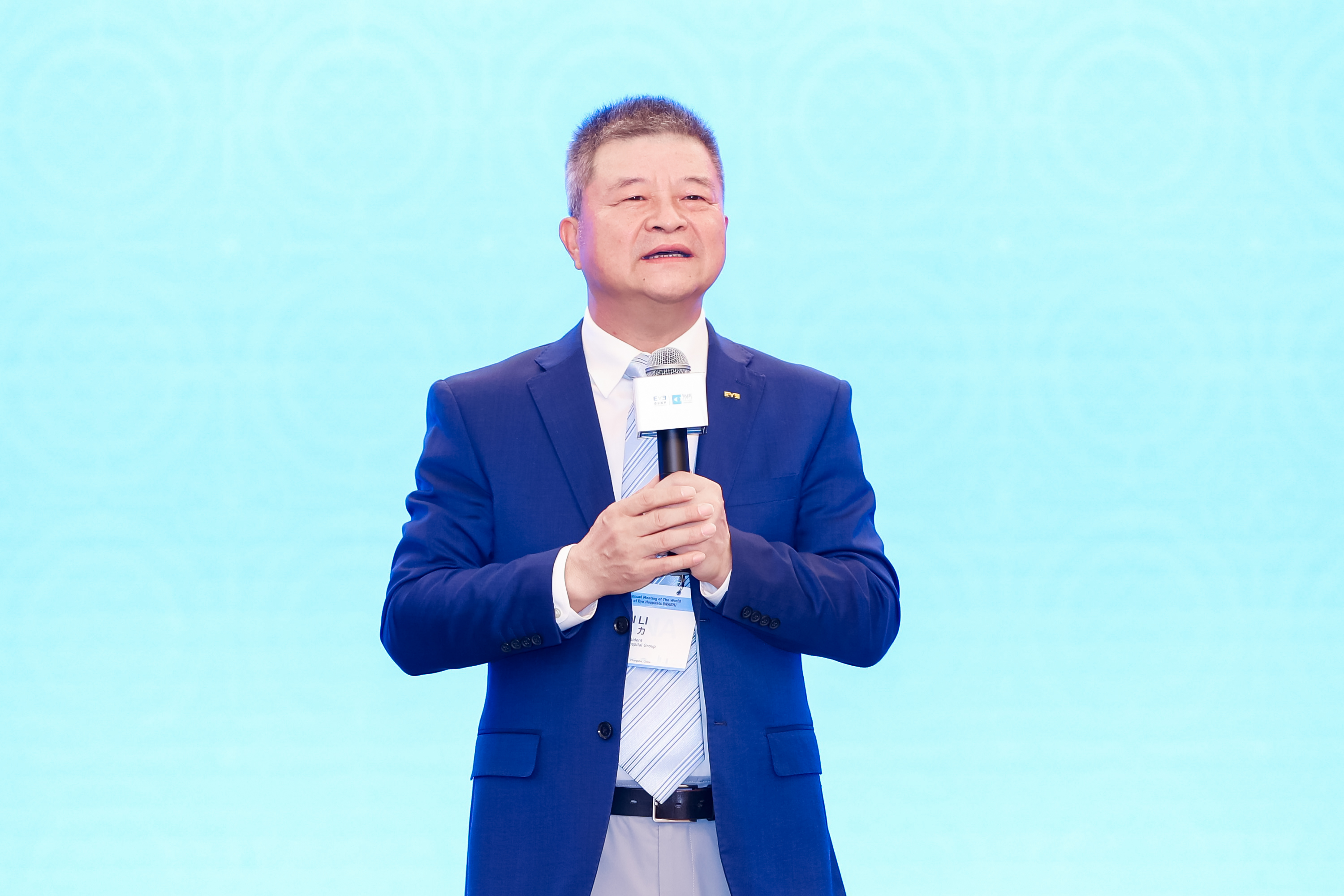
Li Li, CEO of Aier Eye Hospital Group
Li Li, Global CEO of Aier Eye Hospital Group, introduced three major research directions in the field of ophthalmology. The first is basic research, which delves into the mechanisms and pathogenesis of eye diseases at the protein, molecular, and cellular levels to find potential solutions. The second is clinical research, which explores the best treatment options from an evidence-based medicine perspective, utilizing databases and real-world studies. The 18th WAEH Annual Meeting, however, focuses on hospital management, serving as an important conference based on the development principles of healthcare institutions. Li Li hopes that participants will approach the conference from a management perspective and collectively discuss and exchange opportunities for the future of ophthalmology.
This global ophthalmic industry event attracted attention from around the world—over 200 representatives from 35 ophthalmic medical institutions across five continents and 20 countries. Among them were renowned institution management leaders, professional ophthalmologists, research engineers, and strategic development consultants, who came together with domestic peers to exchange and share new ideas and achievements in ophthalmic institution management.
Notable institutions attending include the Singapore National Eye Centre, Moorfields Eye Hospital (UK), Rotterdam Eye Hospital (Netherlands), Royal Victoria Eye and Ear Hospital (Australia), Karolinska University Hospital Ophthalmology Department (Sweden), Wilmer Eye Institute at Johns Hopkins University (USA), Hoftalon Eye Hospital (Brazil), Jakarta Eye Centre (Indonesia), King Khaled Eye Specialist Hospital (Saudi Arabia), Fudan University Eye, Ear, Nose and Throat Hospital (China), Zhongshan Ophthalmic Center, Sun Yat-sen University (China), Tianjin Medical University Eye Hospital (China), Wenzhou Medical University Eye and Optometry Hospital (China), and Aier Eye Hospital Group, among others
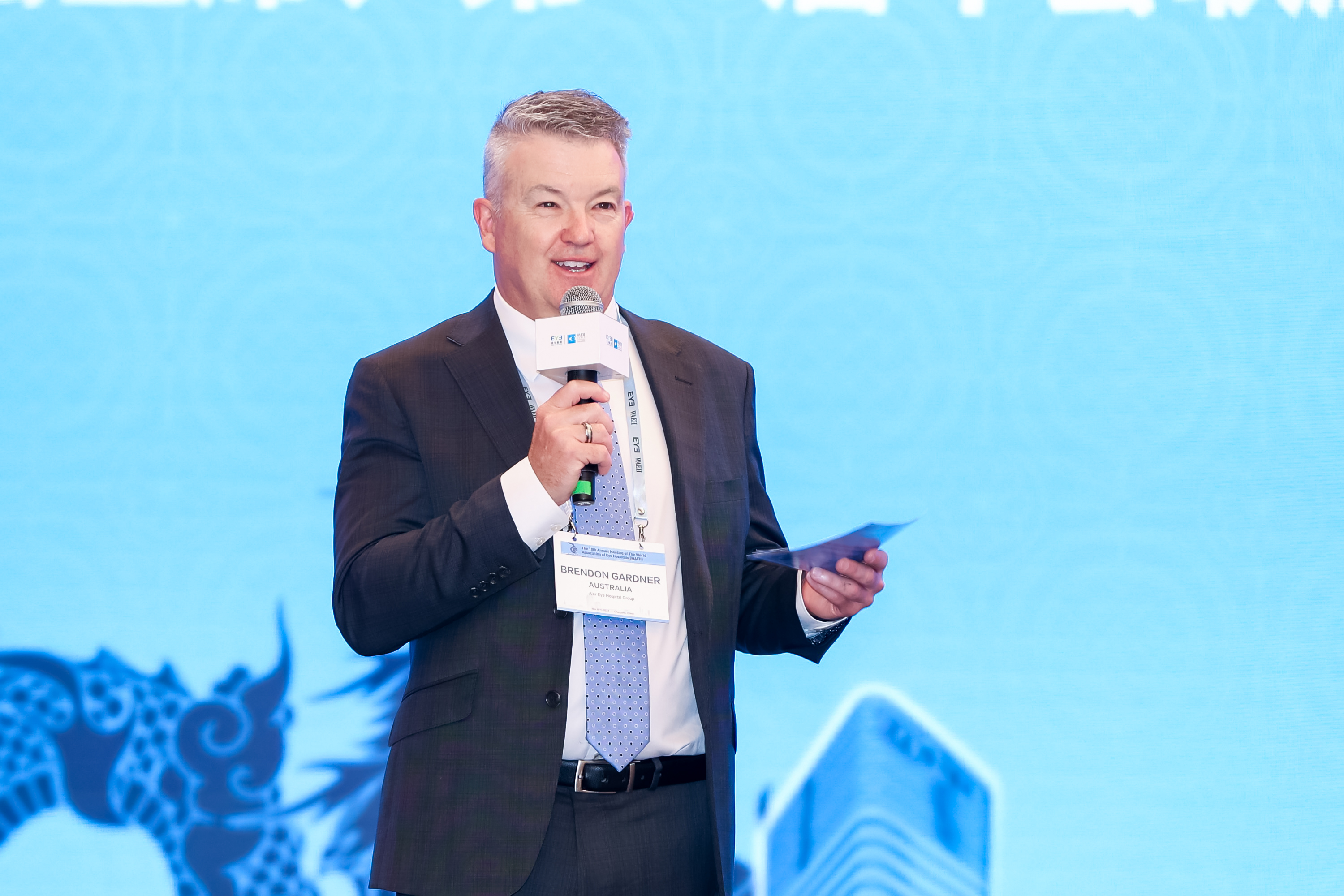
Brendon Gardner, Chairman of the WAEH Board, Co-Chair of the 18th WAEH Annual Meeting, and CEO of the Royal Victorian Eye and Ear Hospital
“Ophthalmic hospital management is a highly specialized field that deserves more attention and sharing among professionals. In the past, medical professionals have typically attended academic conferences focused on sub-specialties such as glaucoma and cataracts, but from a hospital management perspective, there has not been an association like WAEH before. It is the global association dedicated to ophthalmic hospital management.” Brendon Gardner, Chairman of the WAEH Board, Co-Chair of the 18th WAEH Annual Meeting, and CEO of the Royal Victorian Eye and Ear Hospital, stated that the founding purpose of WAEH as an international association was to improve hospital management standards and service capabilities by gathering collective wisdom, ultimately providing better services to eye disease patients.
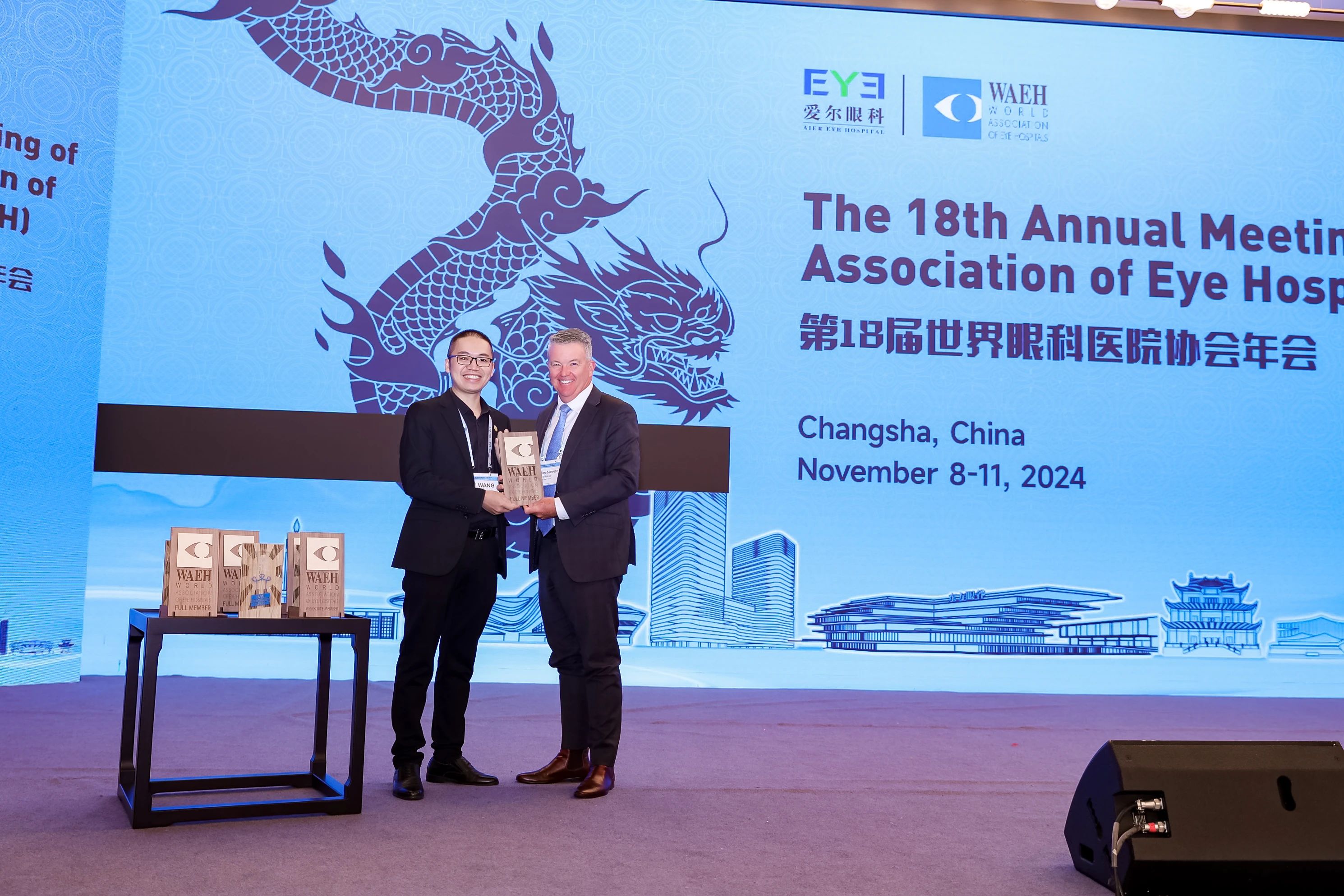
At the 18th WAEH Annual Meeting, Zhongshan Ophthalmic Center, Sun Yat-sen University in China, became a new member of WAEH.
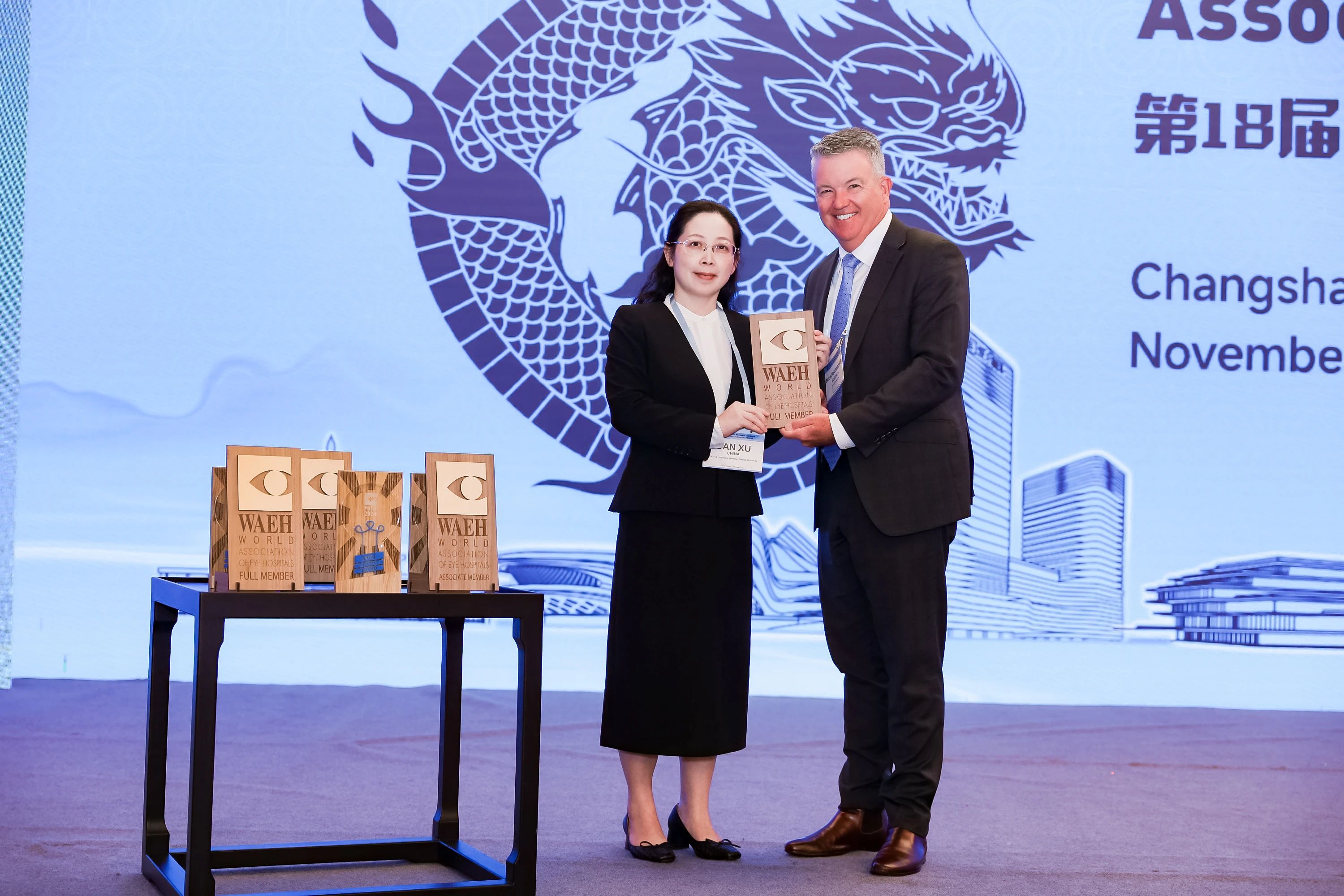
At the 18th WAEH Annual Meeting, Wenzhou Medical University Eye and Optometry Hospital in China became a new member of WAEH.
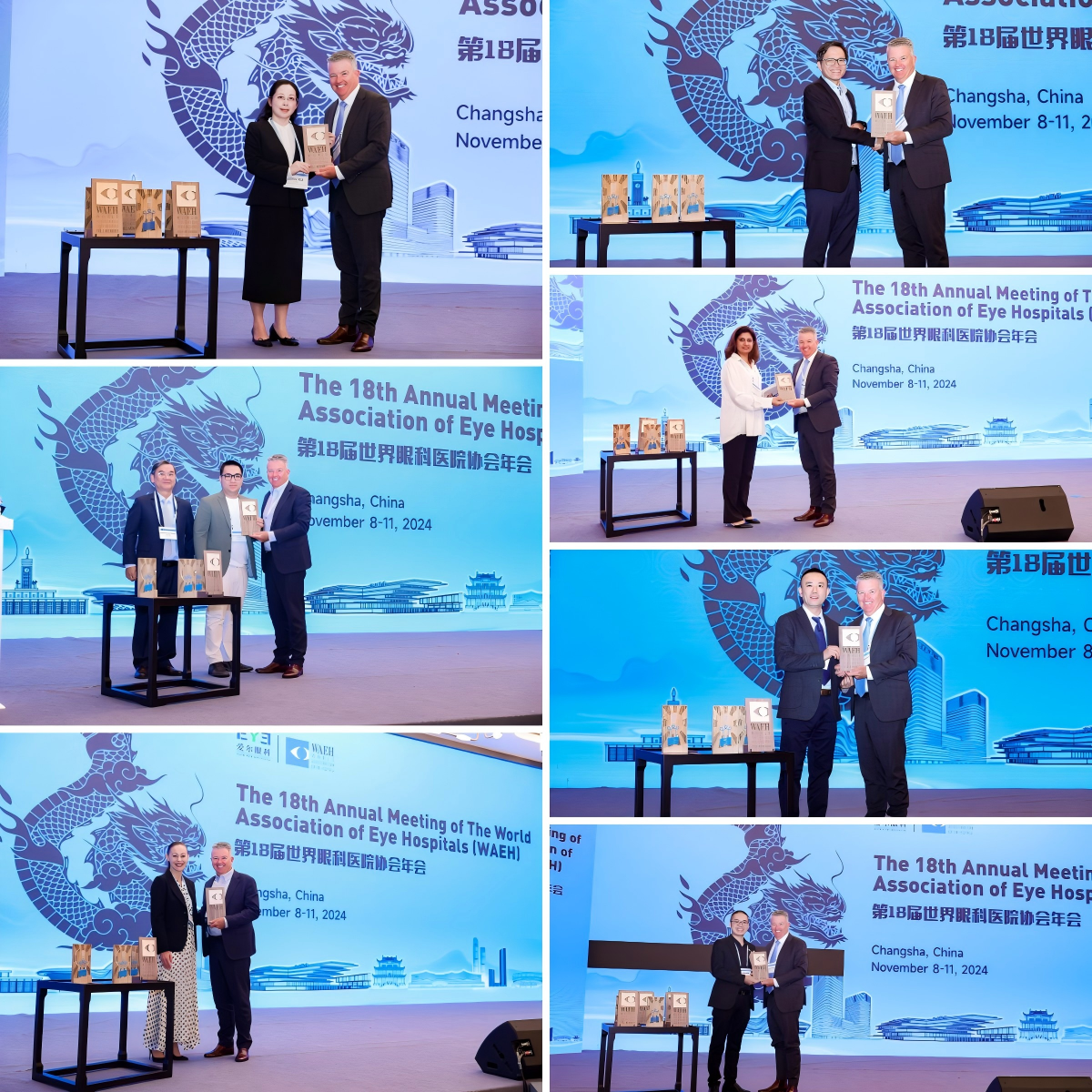
Additionally, five other new member institutions joined WAEH.
As a globally renowned ophthalmic hospital management association, the World Association of Eye Hospitals (WAEH) has over 60 member institutions. At this meeting, seven new member institutions joined, including Zhongshan Ophthalmic Center, Sun Yat-sen University, Wenzhou Medical University Eye and Optometry Hospital, Shenyang Xingqi Eye Hospital in China, as well as Al-Shifa Eye Hospital in Pakistan, Saigon Eye Hospital in Vietnam, Cao Thang International Eye Hospital, and the National Eye Research Institute of Uzbekistan.
It is reported that the key topics of this conference covered areas such as ophthalmic AI and the translation of innovative technological achievements, talent development, patient management, nursing, medical quality management, financial management, and public welfare. The discussions aimed to explore the future trends in ophthalmic management, driving the high-quality growth of the global ophthalmology sector.
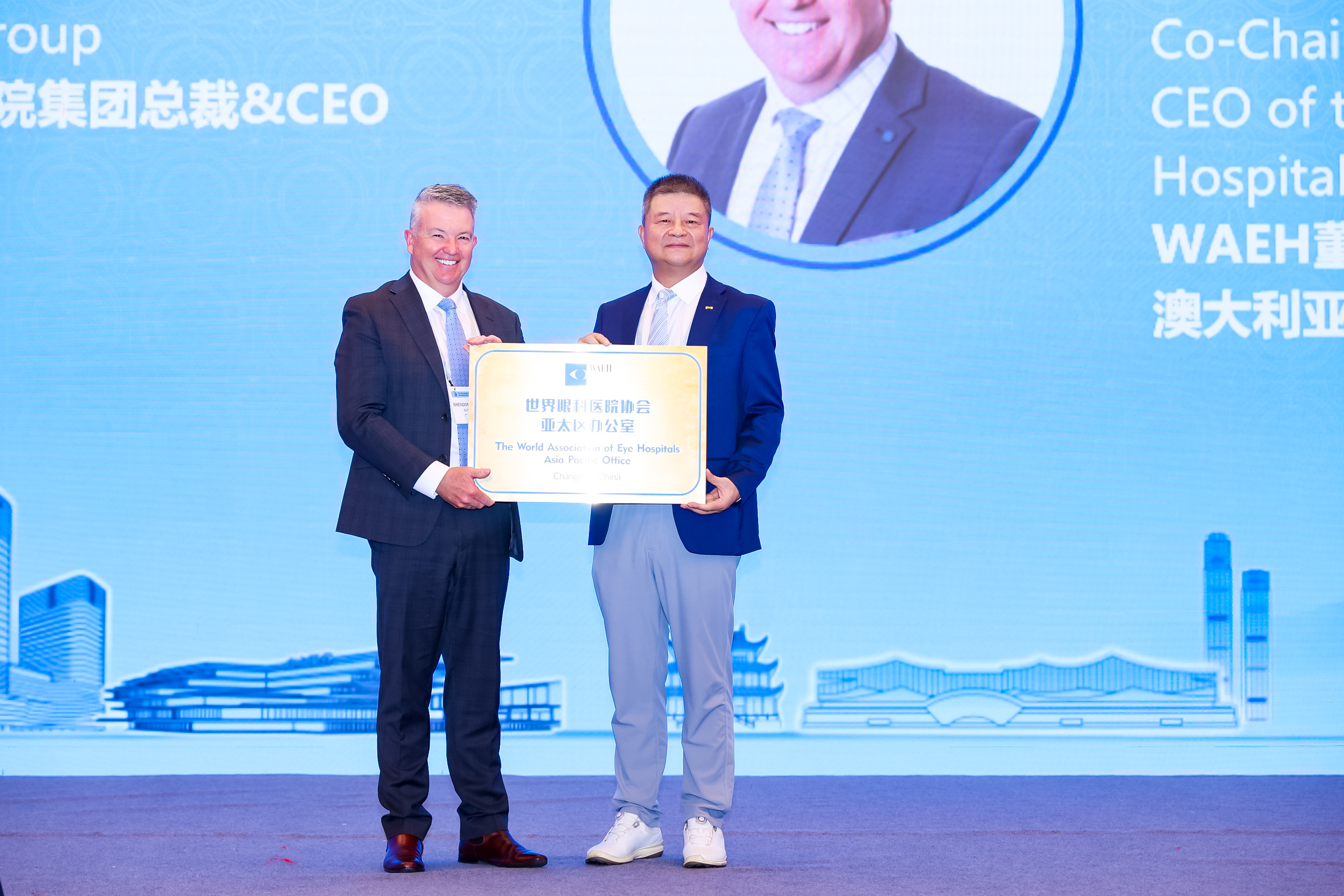
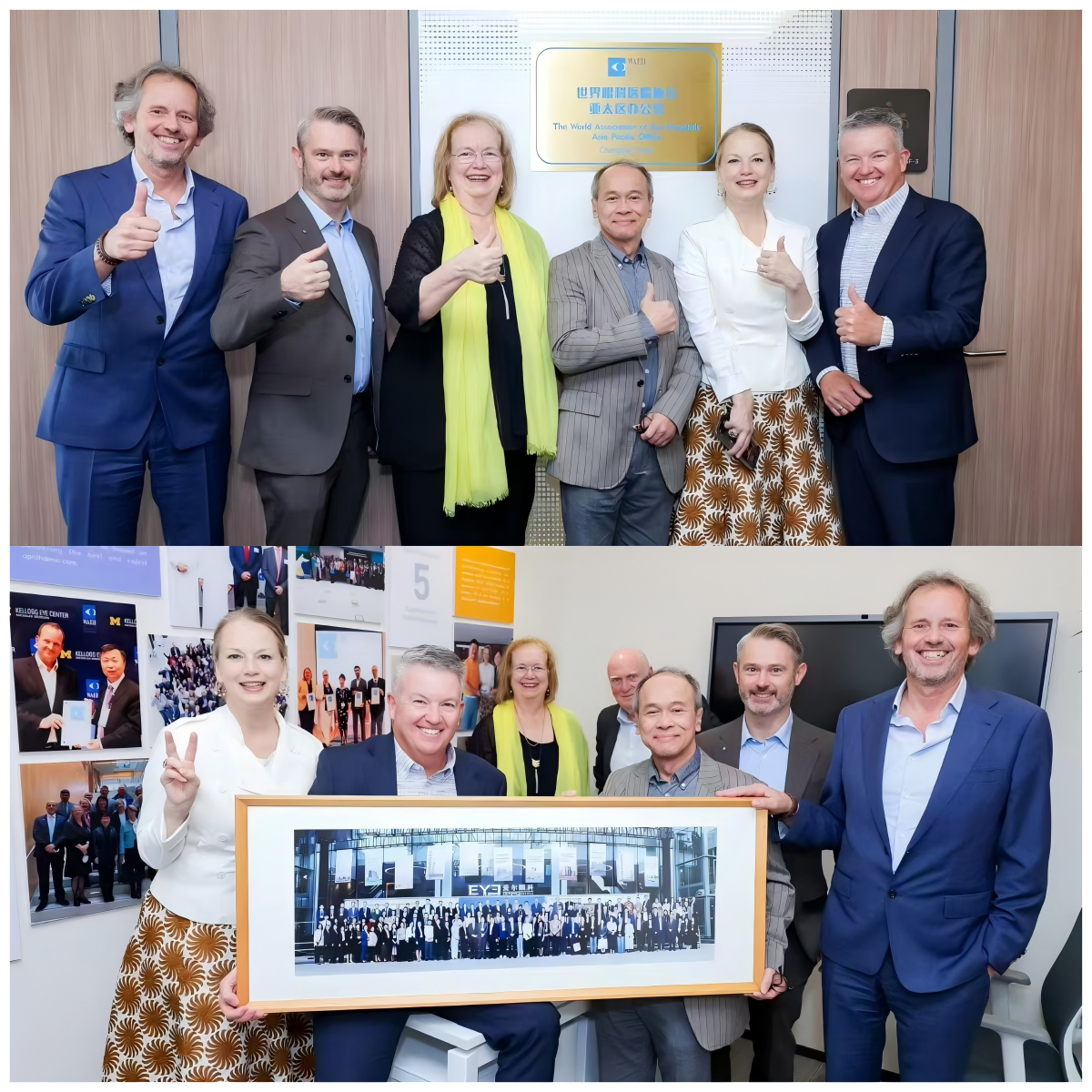
The WAEH Asia-Pacific Regional Office was officially established and located at Aier Eye Hospital.
The WAEH Asia-Pacific office was officially established at the conference. The office is located in Changsha, China, and is based at Aier Eye Hospital Group.
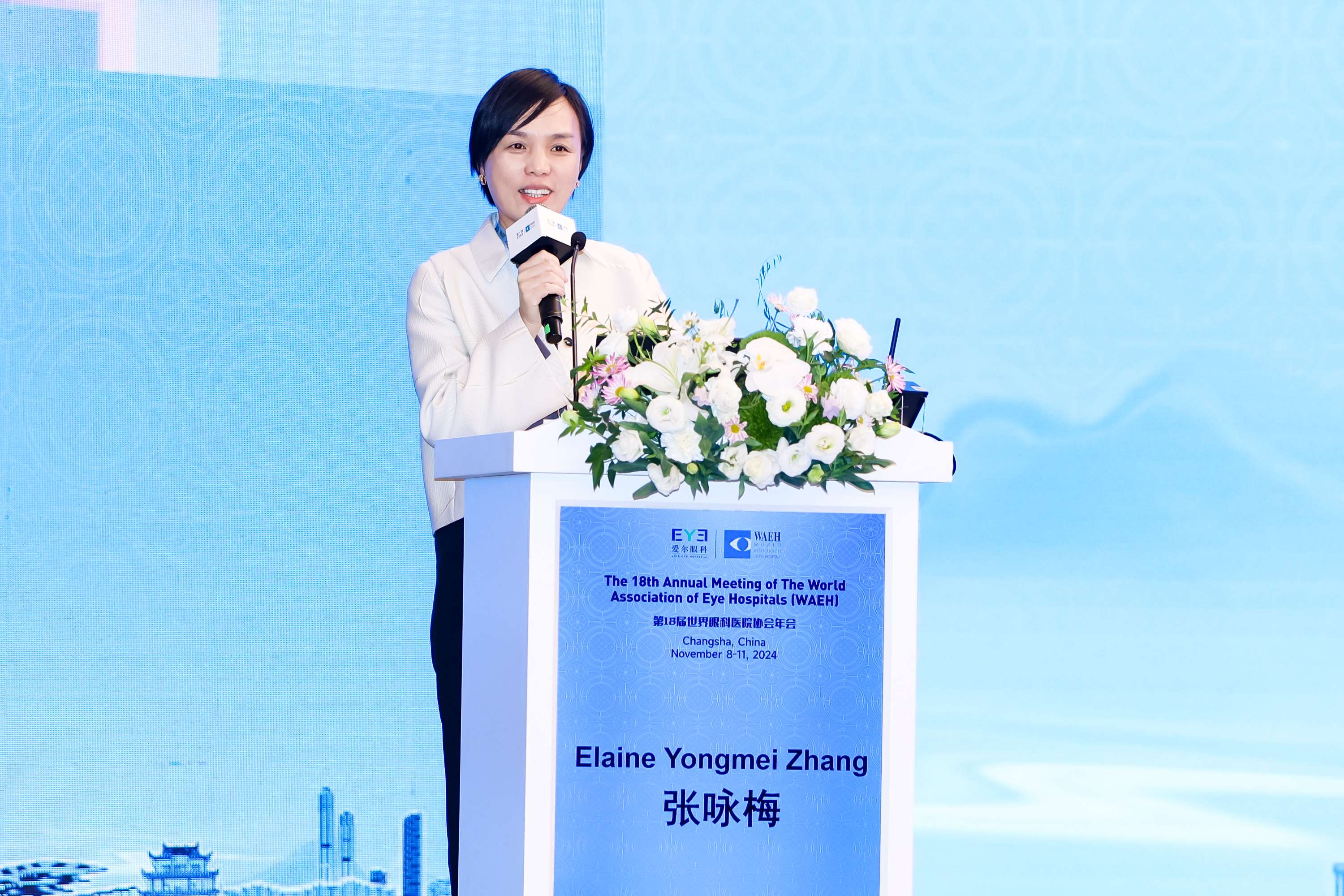
Zhang Yongmei, Vice President of Aier Eye Hospital Group and Co-Chair of the 18th WAEH Annual Meeting
"The Asia-Pacific region, especially Asia, shares similar historical, cultural, and developmental backgrounds. In recent years, with more and more Chinese institutions joining, the WAEH Asia-Pacific region has the largest number of member institutions, reaching 33. Therefore, we invited WAEH to establish the Asia-Pacific Regional Office in Changsha, located at Aier Eye Hospital. Changsha is also fully committed to building a global research and development center city, hoping to gain more opportunities for regional collaboration," said Zhang Yongmei, Vice President of Aier Eye Hospital Group and Co-Chair of the 18th WAEH Annual Meeting. She further explained that the establishment of the WAEH Asia-Pacific Regional Office aims to strengthen communication and collaboration between regional member institutions, such as regularly hosting the WAEH Asia-Pacific Summit and organizing exchanges and study visits to China for Asia-Pacific members. Additionally, it aims to promote cooperation on various projects in the region and address common issues encountered during development."
Looking ahead: Over 50 professional presentations outline a brilliant blueprint for the development of ophthalmology.
With 'the future' as a key theme, the conference focused on in-depth discussions on technological innovations such as artificial intelligence, gene therapy, new materials, and new technologies, aiming to explore how to better 'shape the future.'
Artificial intelligence is driving ophthalmology's growth, fueling research and becoming a key focus for WAEH. Not only does it represent a new direction for current ophthalmic technology development, but it is also seen as one of the key elements in shaping the future of ophthalmology. During the conference, representatives from attending institutions enthusiastically shared their latest research achievements in this field.
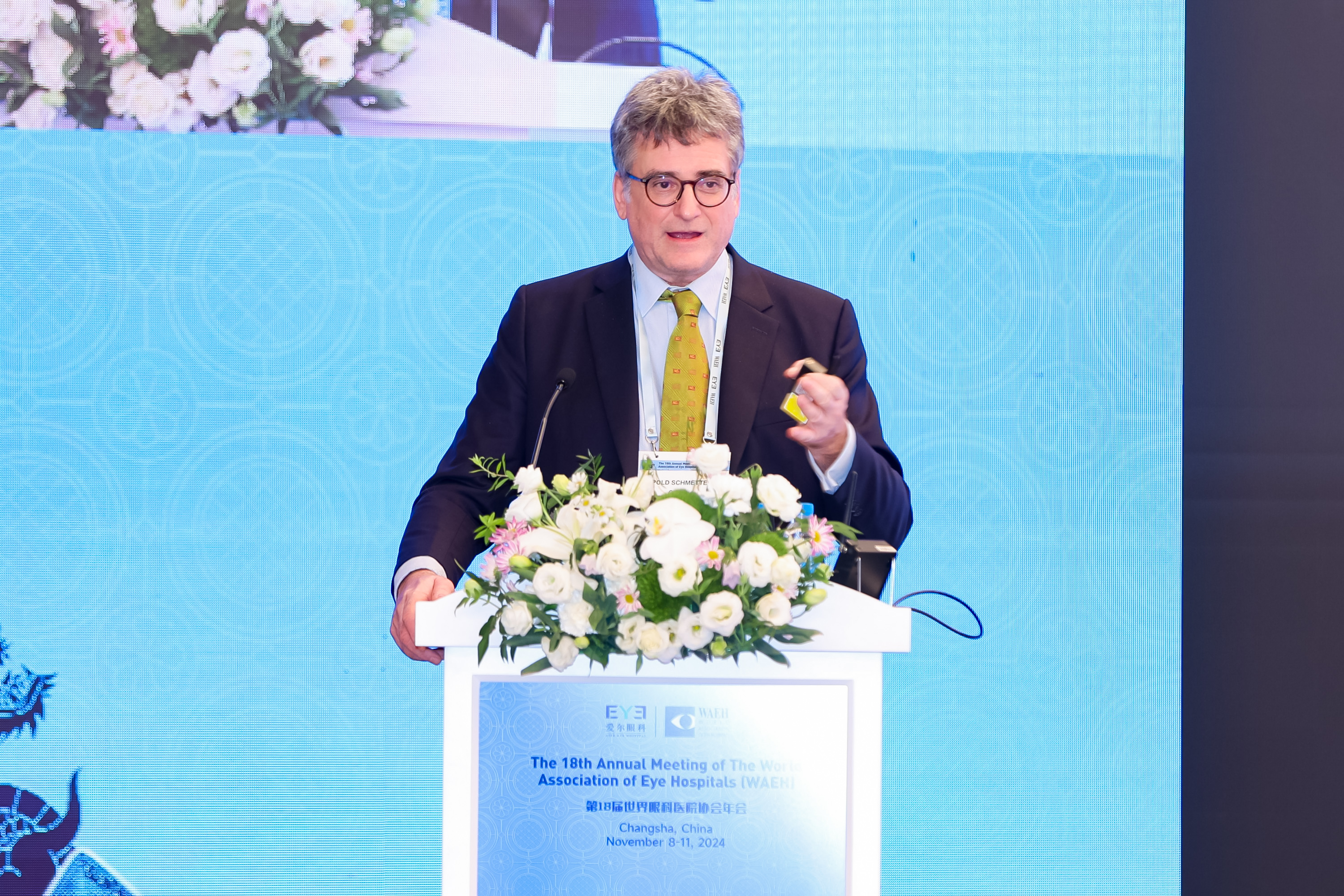
Leopold Schmetterer, Member of the Global Scientific Advisory Board of Aier Eye Hospital Group
Leopold Schmetterer, a member of the Global Scientific Advisory Board of Aier Eye Hospital Group, highlighted in his report "Barriers to Translating Artificial Intelligence Solutions into Clinical Practice" that while AI solutions are gaining widespread attention in the field of ophthalmology, there are still several challenges in applying them clinically. These challenges include the applicability of external real-world datasets and the inadequacy of screening facilities, among other factors.
The Johns Hopkins Wilmer Eye Institute has established an Artificial Intelligence Innovation Center. This center serves as a hub, dedicated to researching and implementing the application of AI across various domains, including clinical research, academic studies, medical education, and patient care.

Dr. Fardowsa Diri, Moorfields Eye Hospital, UK
Moorfields Eye Hospital in the UK uses virtual reality (VR) technology to enhance patient care, including improving staff professionalism and compassion when caring for patients with impaired abilities.
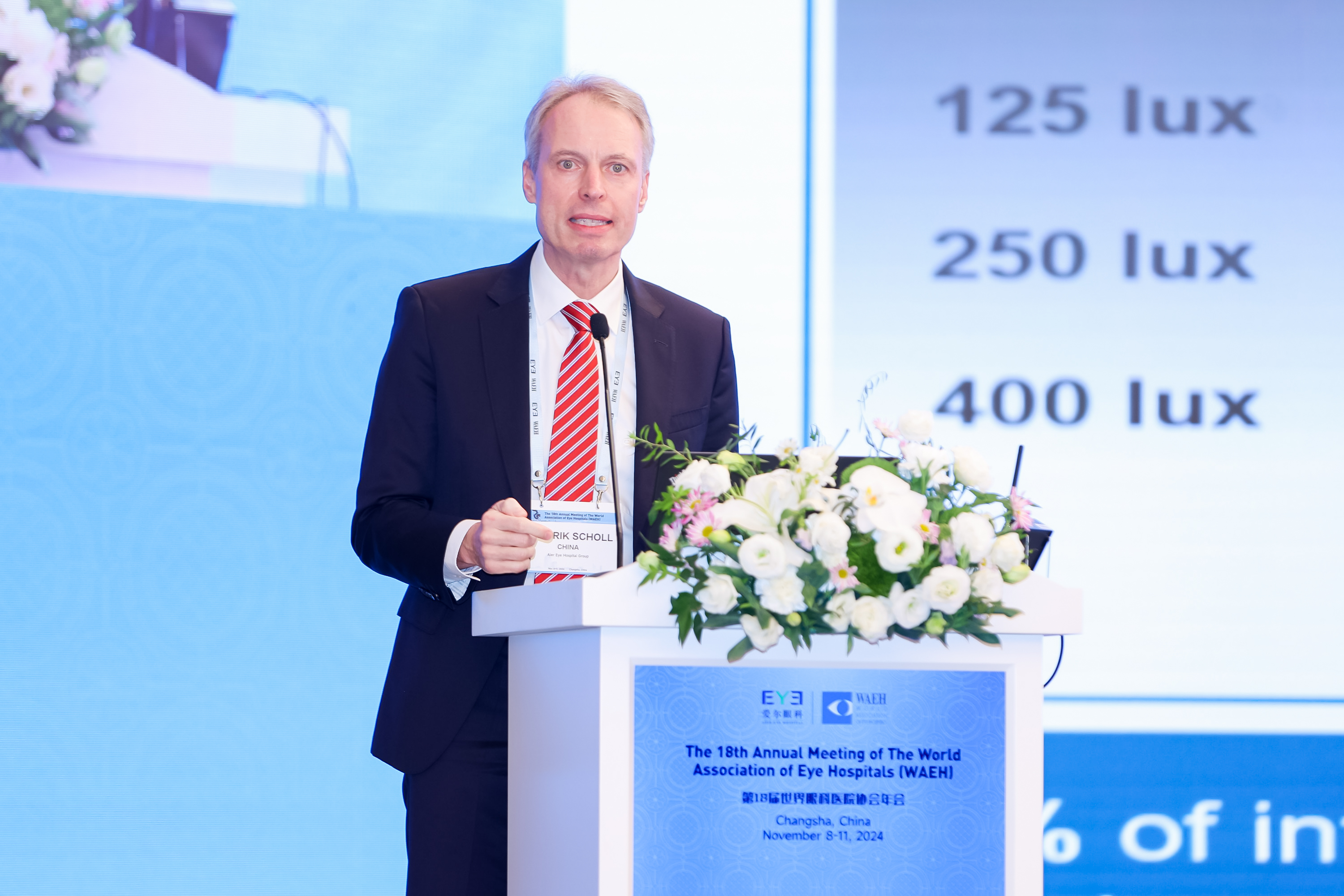
Hendrik P.N. Scholl, member of the Global Scientific Advisory Board of Aier Eye Hospital
Gene therapy brings new hope for genetic eye diseases. Hendrik P.N. Scholl, a member of Aier Eye Hospital’s Global Scientific Advisory Board, pointed out in his speech on "Advances in Gene Therapy for Retinal Diseases" that the human retina is susceptible to diseases caused by genomic mutations. Gene therapy, through the modification of genetic material, offers the potential to treat or prevent diseases. Techniques such as gene enhancement and gene base editing are at the forefront of personalized medicine and have the potential to revolutionize the treatment of genetic diseases. However, challenges remain in gene delivery methods, long-term efficacy, and ethical concerns, requiring continuous research for the further development of gene therapy.
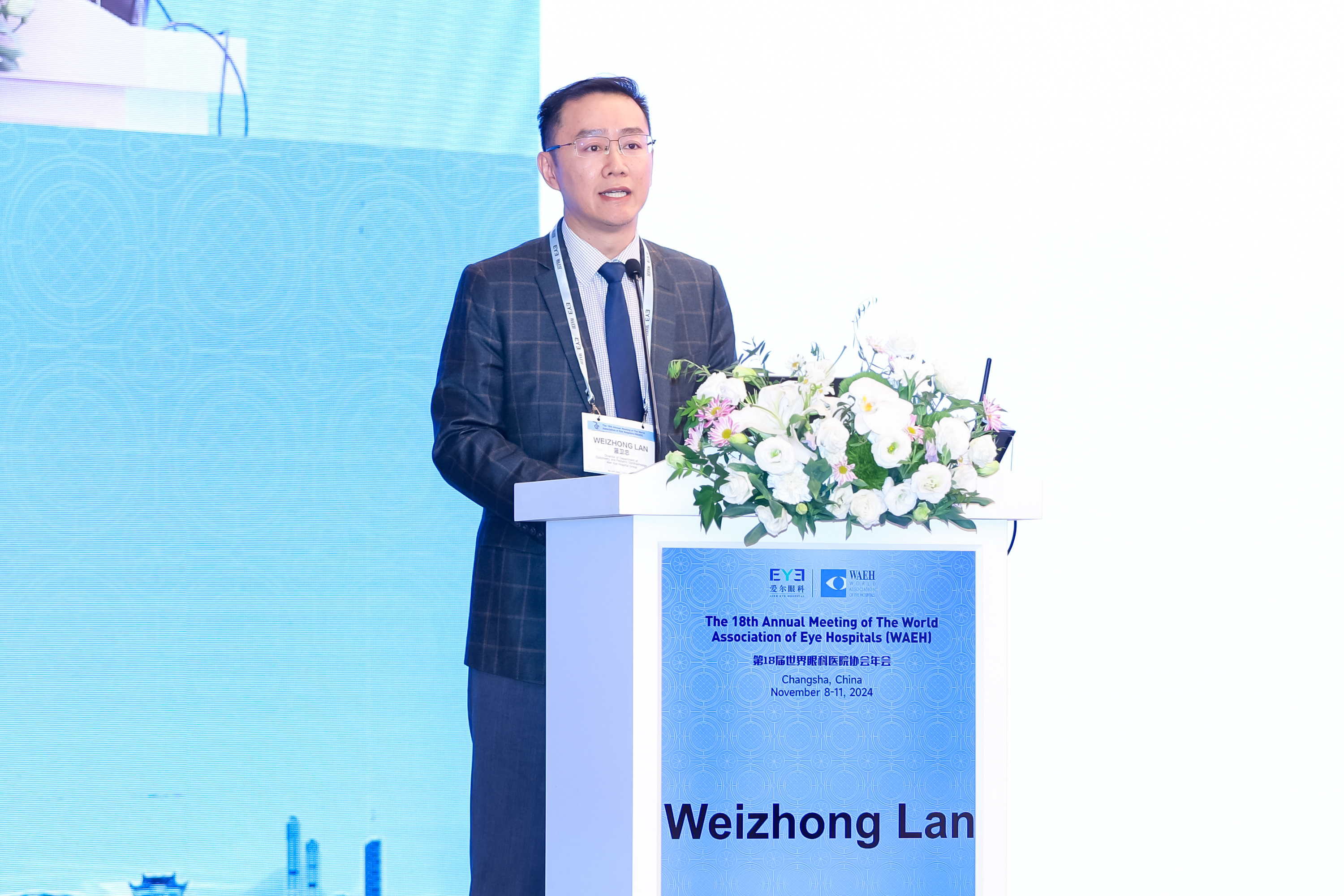
Professor Lan Weizhong, Deputy Director of the Eye Optometry Research Institute
With rapid technological advancements, new technologies have become a key driving force for the development of ophthalmic hospitals. Professor Lan Weizhong, Deputy Director of the Eye Optometry Research Institute, shared his report titled 'Mapping the Future: The Road to Next-Generation Myopia Control Lens Design.' His team successfully developed the innovative Wide-Angle Retinal Refractive Topography Measuring Instrument (VPR), which can measure and map the wide-angle retinal refractive errors in just a few seconds. This technology lays a critical foundation for personalized myopia fitting and achieving better myopia control outcomes.
Focus on Management: WAEH is dedicated to advancing the high-quality growth of the global ophthalmology industry.
In the medical field, the development of medical technologies is crucial, as it provides strong support for the diagnosis and treatment of diseases. However, advanced technology alone is not enough. Patients, during their healthcare journey, not only seek effective treatment but also expect humane care and services.
Hospital management aims to prioritize patients, streamline clinical pathways, enhance medical services, and strengthen quality management — all of which are just as crucial as advancing medical technologies.
This conference achieved significant results in the field of ophthalmic management. Attendees actively shared innovative experiences. They brought valuable insights and practical experiences on various aspects such as ophthalmic talent training, nursing work, patient services, medical quality management, and the sustainable development of hospitals.

Catherine Manusco, The Ophthalmic Diagnostics Service Manager of the Royal Victorian Eye and Ear Hospital
Catherine Manusco, Ophthalmic Diagnostic Services Manager at the Royal Victorian Eye and Ear Hospital in Australia, gave an online presentation titled "Advanced Axial Correction Practice - A One-Year Pilot Project." She shared insights on how the project incorporated "Ophthalmic Champions" to support the training and development of Advanced Practice Optometrists (APOs). Her talk covered key aspects of the project, including clinical practices, scope of practice, workforce challenges, and collaborative care, while also showcasing the increased confidence levels of APOs and the positive impact of the program on patient experience.

Jos Hubers, Deputy CEO and HR Director of Rotterdam Eye Hospital
Jos Hubers, Deputy CEO and HR Director of Rotterdam Eye Hospital, presented a report titled "Preliminary Results of the WAEH Exchange Program — Establishment of the HR Practitioners' Community" at the conference. He emphasized that video-based communication and sharing between WAEH eye hospitals greatly enhance mutual learning among staff, applying practices that improve the standard of eye care at the hospitals.
It is reported that the World Association of Eye Hospitals (WAEH) board consists of 11 member organizations, with Aier Eye Hospital Group being the only Chinese member. In September 2017, Aier Eye Hospital acquired Bavaria's Optimax Group, becoming a global eye care chain, attracting worldwide attention.
In February 2018, Aier Eye Hospital was invited to officially join WAEH as a member, and in September 2021, it was elected to the board of directors. As a board member, Aier has provided a vital platform for Chinese ophthalmic institutions to represent their views on the global stage. Since Aier's inclusion, numerous Chinese eye hospitals have also applied to join WAEH.
"Currently, nearly 10 Chinese eye institutions have joined WAEH. We look forward to more Chinese institutions joining, to strengthen collaboration and exchange with international institutions, and to truly integrate with global standards, learning the best management practices internationally," said Li Li, Global President of Aier Eye Hospital Group. "China's clinical ophthalmology is already on par with international standards, but some cross-disciplinary collaborations and the mechanisms for translating technological advancements abroad are ahead of China in certain equipment and scientific discoveries."
" We can learn from one another, leveraging each other's strengths to overcome weaknesses. For example, one of the hosts of the next annual meeting, the National 15-20 Hospital in Paris, France, has a history of 800 years. Also, the Rotterdam Eye Hospital in the Netherlands, one of the founding institutions of WAEH, is celebrating its 150th anniversary. We are eager to learn from these historically rich, experienced, and renowned eye care institutions to bring more global ophthalmic management wisdom to China, further advancing the development of China's eye care sector."
Aier’s Journey: Paving the Way for Global Expansion and Sharing Innovative Achievements Worldwide
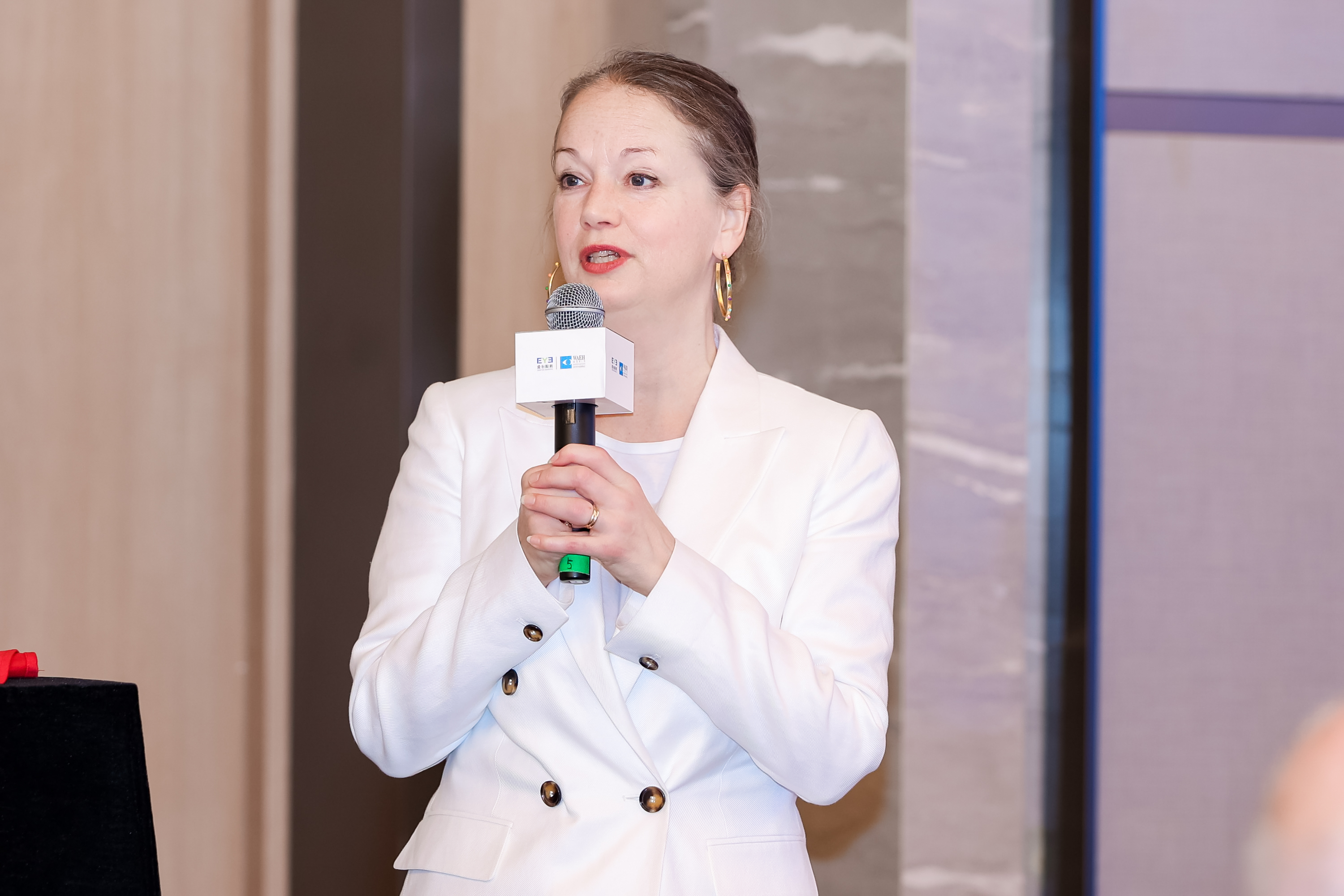
Maaike Van Zuilen, Secretary General of the World Association of Eye Hospitals (WAEH)
Maaike Van Zuilen, the Secretary-General of the World Association of Eye Hospitals (WAEH), pointed out, "Aier Eye Hospital has over 800 eye institutions worldwide, with an annual outpatient volume exceeding ten million. With such a massive outpatient volume, how it manages to run its branches efficiently is quite intriguing, which is why everyone is eager to visit China to see it."
It is reported that Aier Eye Hospital focuses on three strategic objectives: "strengthening the grassroots, building heights, and promoting integration." The organization has fully committed to constructing six major eye health ecosystems, including graded chain ecosystems, Intra-city network ecosystems, digital ophthalmology ecosystems, education and research ecosystems, global development ecosystems, and sustainable public welfare ecosystems.
At this conference, Aier Eye Hospital shared its rich and valuable experiences and outstanding achievements in areas such as global development, technological innovation and results transformation, talent cultivation, digital ophthalmology development, and public welfare.
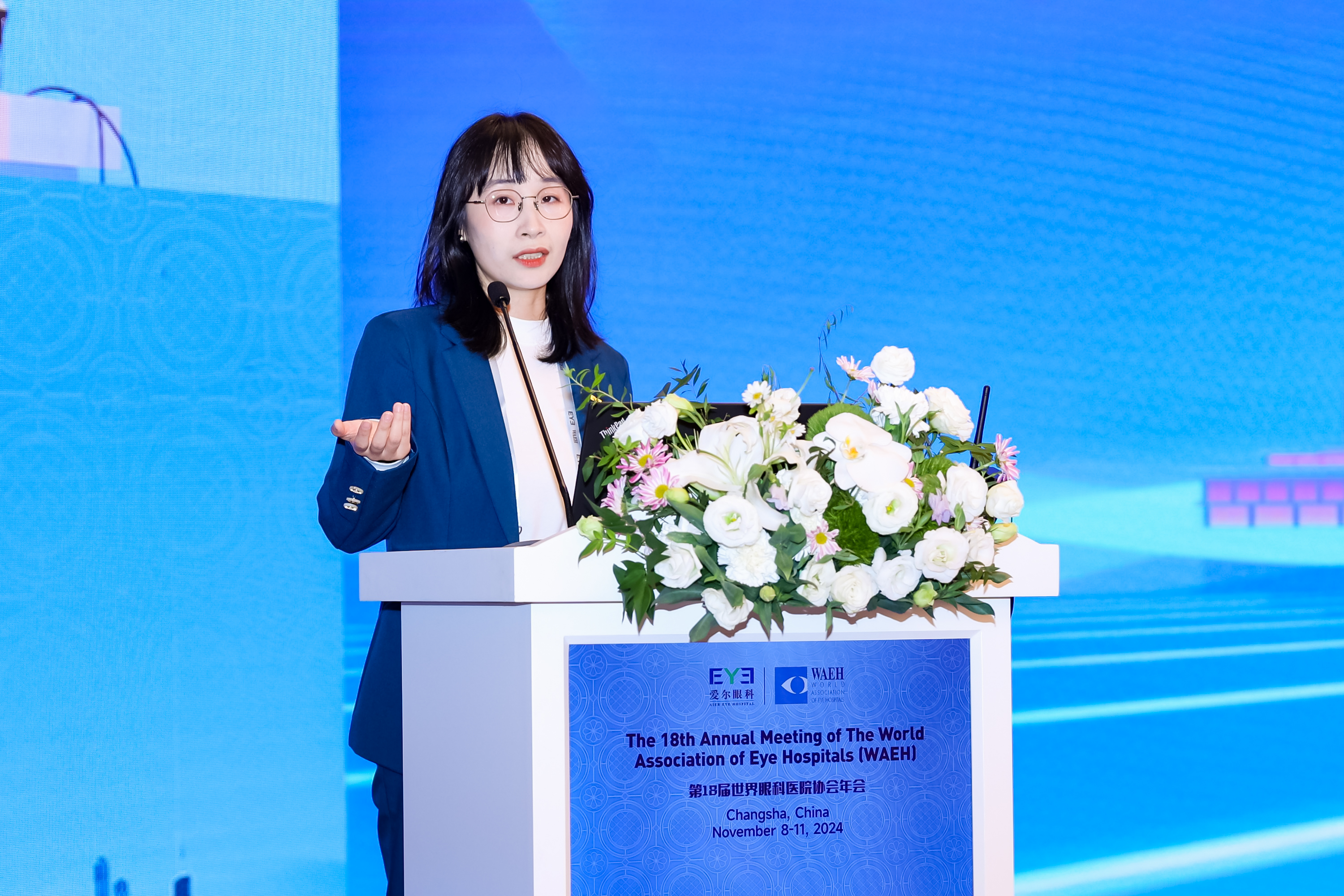
Zhan Tianjiao, The Deputy Director of the Human Resources Center at Aier Eye Hospital Group
Talent is the Priority. Tan Tianjiao, Deputy Director of the Human Resources Center of Aier Eye Hospital Group, stated that over the past two decades, Aier Eye Hospital has closely aligned with the career development needs and paths of ophthalmologists, actively exploring and successfully establishing a distinctive ophthalmologist training system with Aier's unique features.

Xiang Bin, Director of the Science and Education Center of Aier Eye Hospital Group
Technology is the primary productive force. Xiang Bin, Director of the Education and Research Center at Aier Eye Hospital Group, introduced that Aier Eye Hospital has always adhered to the strategy of "innovation-driven, technology-oriented," focusing on building an education and technology innovation ecosystem, establishing an eye health service ecosystem, and using technological innovation as support to lead high-quality development.
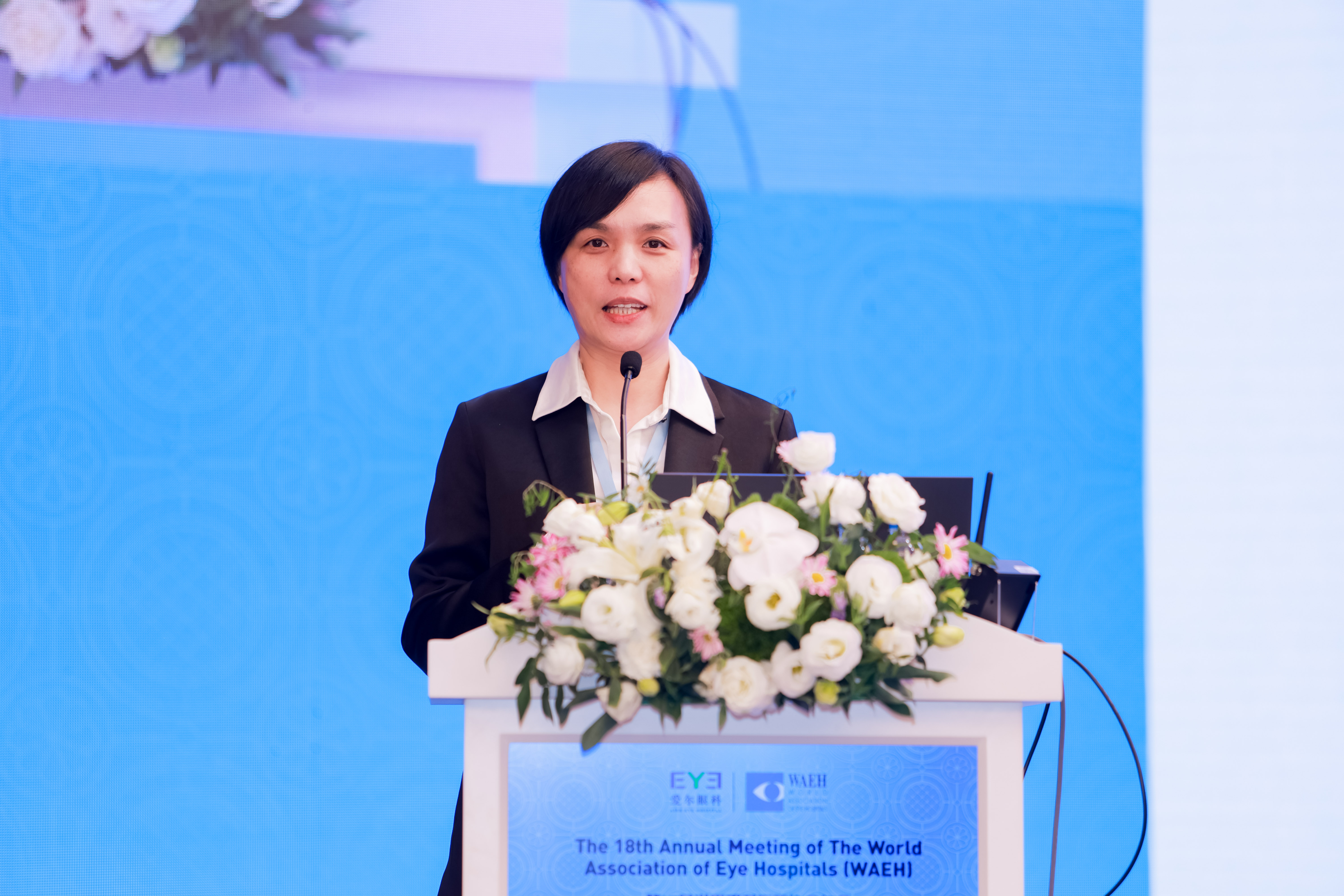
Zhang Yongmei, Vice President of Aier Eye Hospital Group and Co-Chair of the 18th WAEH Annual Meeting
Technology transfer is a key driving force for the sustainable development of ophthalmic hospitals. Zhang Yongmei pointed out that for many years, Aier Eye Hospital has achieved significant results in technology transfer. The group has established a technology transfer platform, set up an industry incubation fund, built supporting industrial parks, and linked upstream and downstream resources to promote the conversion of research outcomes into new productive forces. The goal is to create a complete industrial chain ecosystem that spans from basic scientific research to commercialization and clinical services.
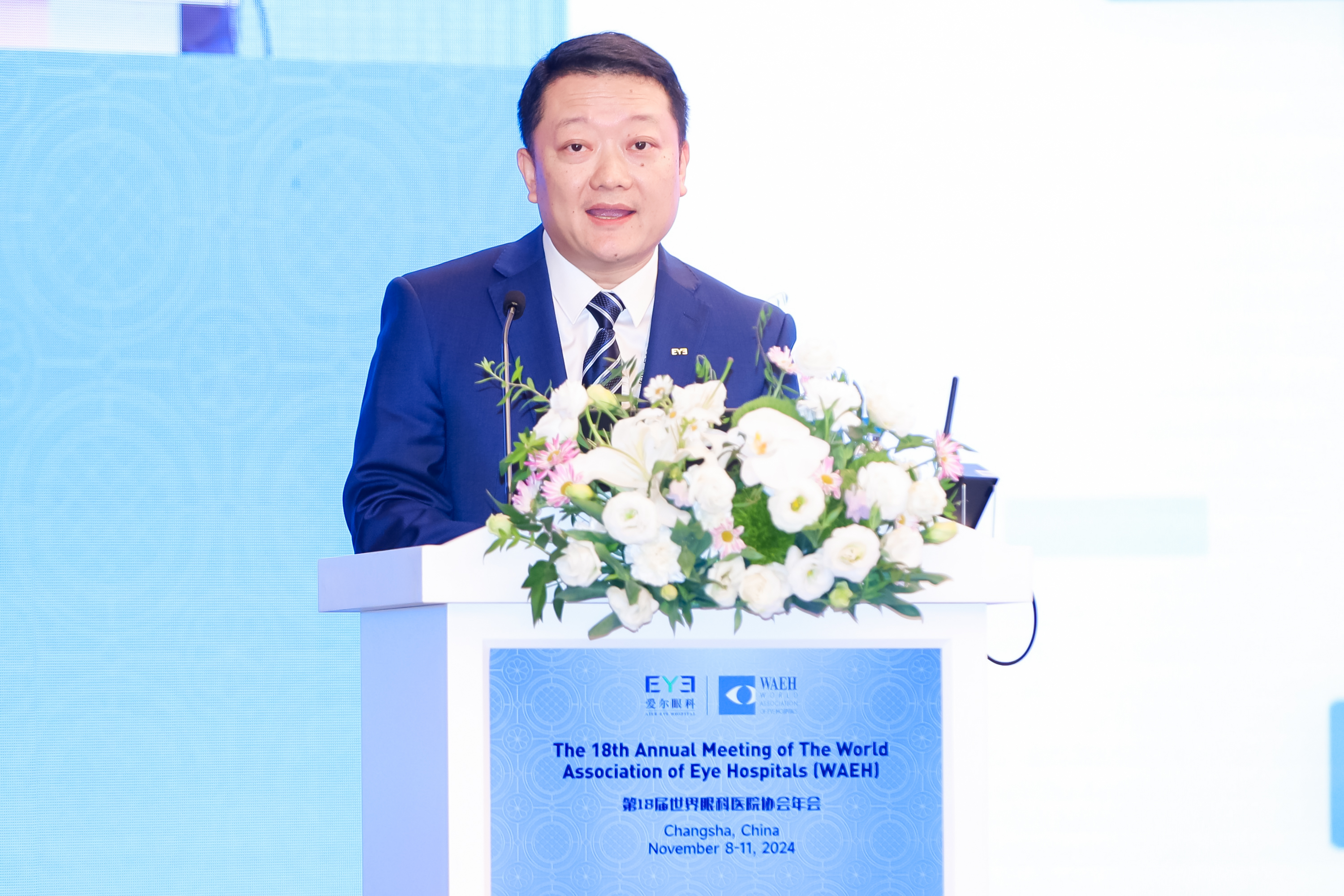
Tang Fan, Director of the Information Center at Aier Eye Hospital Group
Digital construction is a key initiative to accelerate Aier Eye's development. Tang Fan, Director of the Information Center at Aier Eye Hospital Group, shared Aier Eye's journey in leading the medical informatization construction with self-developed technologies. Over the years, Aier Eye has made significant progress in medical digitalization and infrastructure development, adopting a hybrid cloud model to establish a "four clouds and two centers" architecture system.
Peng Zhikun, Deputy Party Secretary of Aier Eye Hospital Group, introduced Aier Eye's sustainable public welfare ecosystem built through the cross-subsidy public welfare model. This model primarily channels profits from high-end medical services to subsidize low-income groups of eye disease patients, ensuring long-term ophthalmic medical assistance for patients with difficult eye diseases.
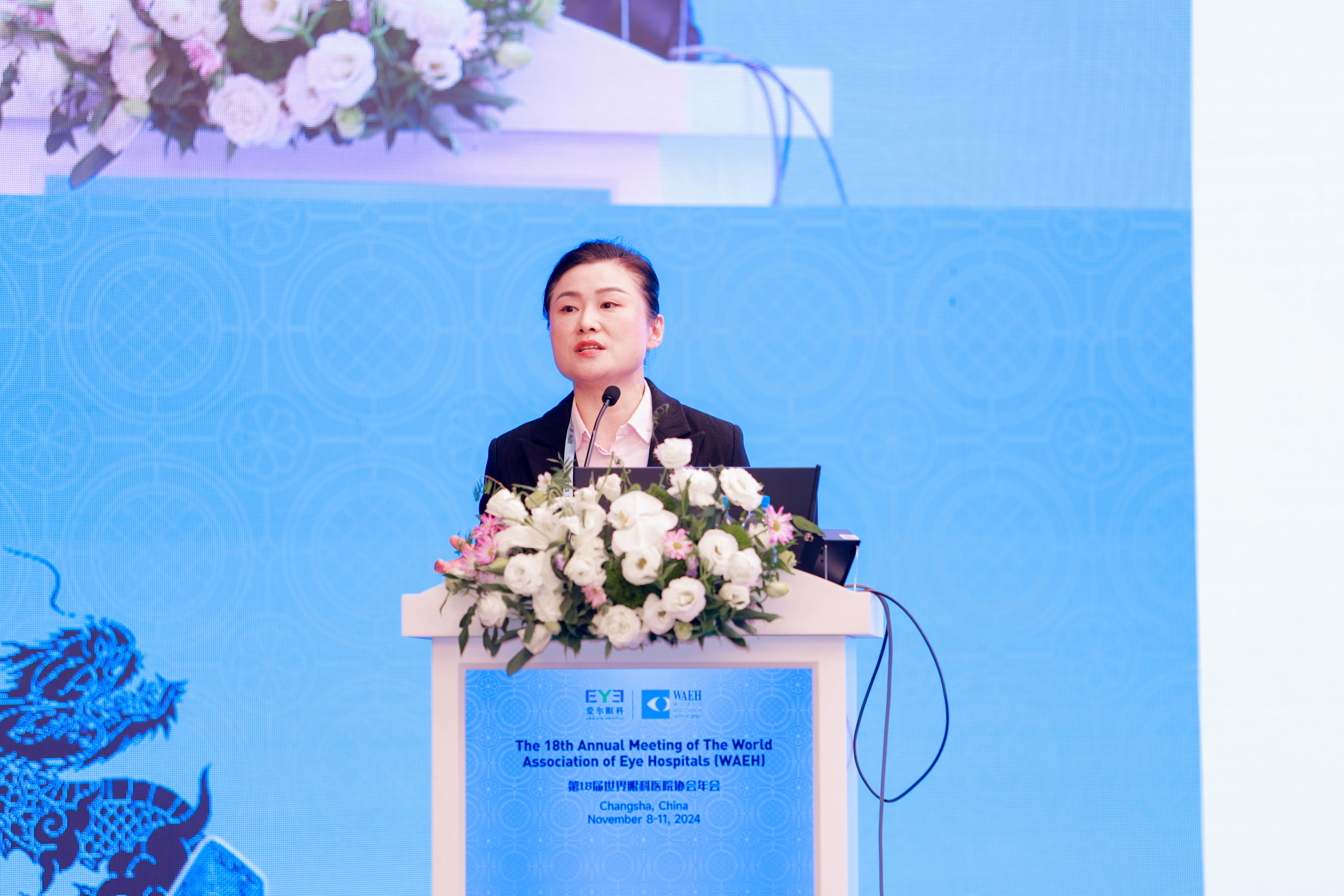
Feng Jun, Vice President at Aier Eye Hospital Group
Aier Eye Hospital Group's Vice President, Feng Jun, stated that after 22 years of development, Aier Eye Hospital has become a global ophthalmic medical chain group, covering three continents: Europe, America, and Asia. Aier Eye Hospital has always focused on the patient, committed to developing first-class technology and integrated disciplines. By establishing a digital intelligent system to improve medical convenience, the hospital has also built a service improvement system for the value chain.
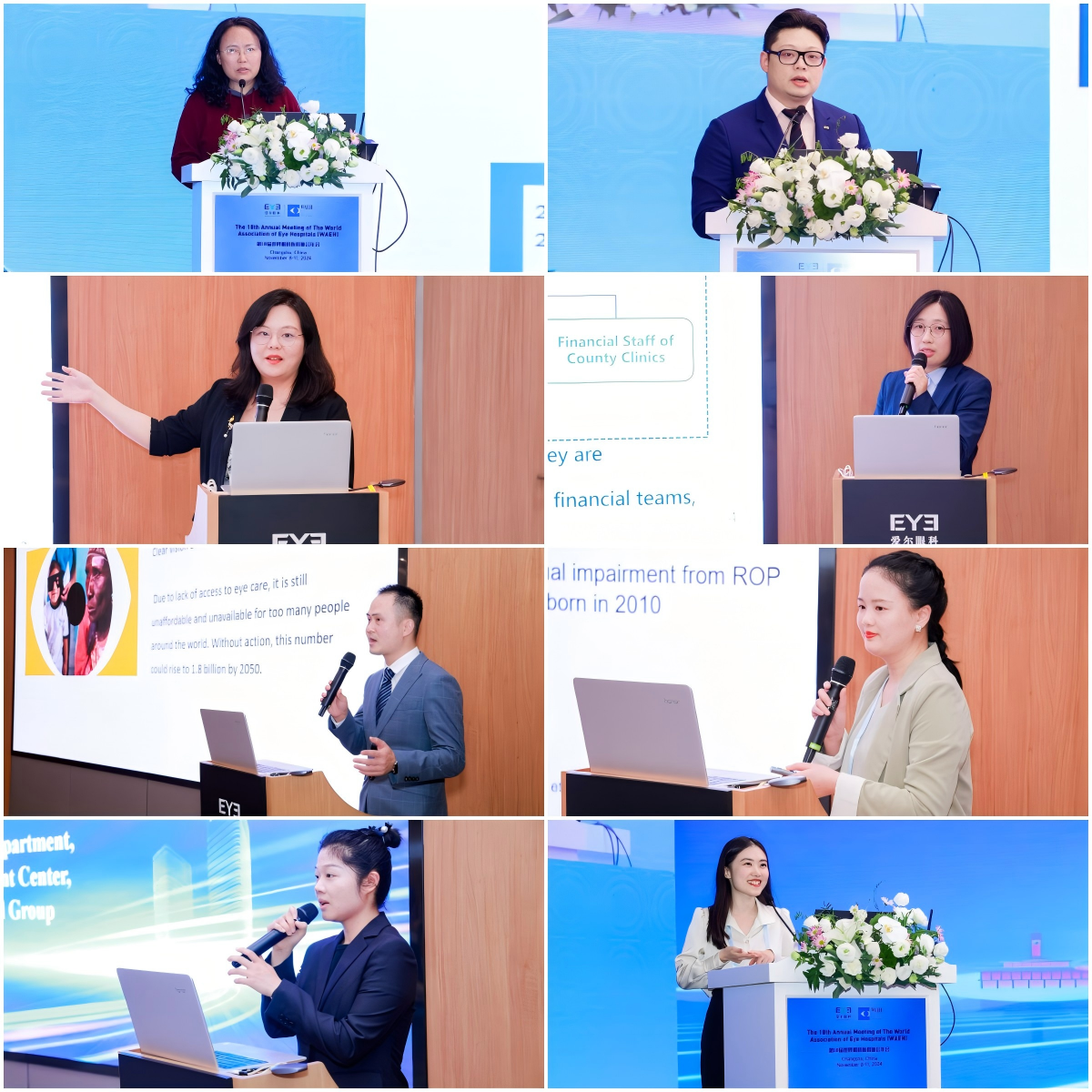
Representatives from various sectors of Aier Eye Hospital Group shared their insights.
In 2023, at the closing ceremony of the 17th WAEH Annual Meeting held in Melbourne, Aier Eye Hospital successfully won the bid to host the 18th WAEH Annual Meeting. This marks the second time the WAEH Annual Meeting has been held in China after a gap of seven years.
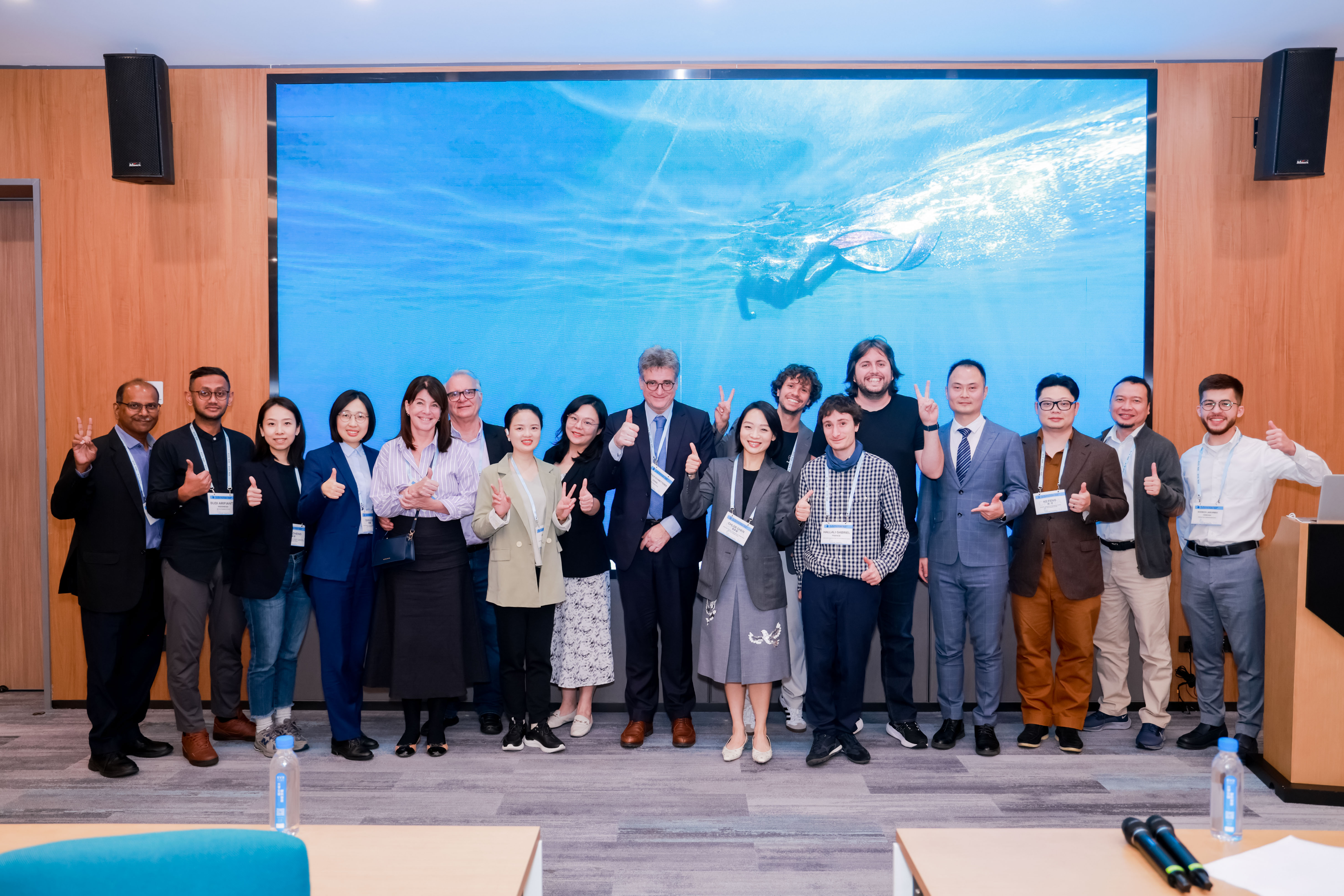
Aier Eye Hospital and other Chinese member hospitals shared their experiences.
Charity Wai, Honorary Board Member of the World Association of Eye Hospitals (WAEH) and recipient of the WAEH Lifetime Achievement Award, stated, "Aier Eye Hospital has taken eye hospital management to such a level of detail and professionalism that it is truly remarkable. This is why we invited Aier to join WAEH and use its success as a model for sharing experiences. While most overseas eye care chains focus on one or two specialties, such as refractive surgery or cataracts, Aier stands out by offering comprehensive eye care services covering all areas of ophthalmology."
Aier's international expansion and tiered chain model have also inspired many member institutions.

Wilson Takashi Hida, Chairman of Medical Affairs and Board Member of Opty Eye Hospital Group in Brazil
In 2017, the Opty Eye Hospital Group in Brazil was just established, with only a few eye care institutions under its umbrella. Wilson Takashi Hida, Chairman of Medical Affairs and Board Member of the group, traveled to China to learn from the Aier Eye Hospital team about managing branch institutions. He then visited Aier's European, Southeast Asian, and American branches for further in-depth learning and exchange. Within just a few years, Opty Eye Hospital Group has become the largest eye care chain in Brazil and is now a member of WAEH.
"We are pleased to see that, with the flourishing development of Chinese ophthalmic institutions, many outstanding Chinese experiences are being shared globally. This annual conference is the first one hosted by Aier Eye Hospital since joining WAEH. We warmly welcome all member representatives to China to experience the changes and developments in Chinese ophthalmic institutions. In the future, we hope Aier can continue to play the role of 'international ambassador for ophthalmic exchange,' sharing advanced ophthalmic management experiences and technologies globally, benefiting eye disease patients worldwide and driving the advancement of human visual science and ophthalmology," said Chen Bang, Chairman of Aier Eye Hospital Group.
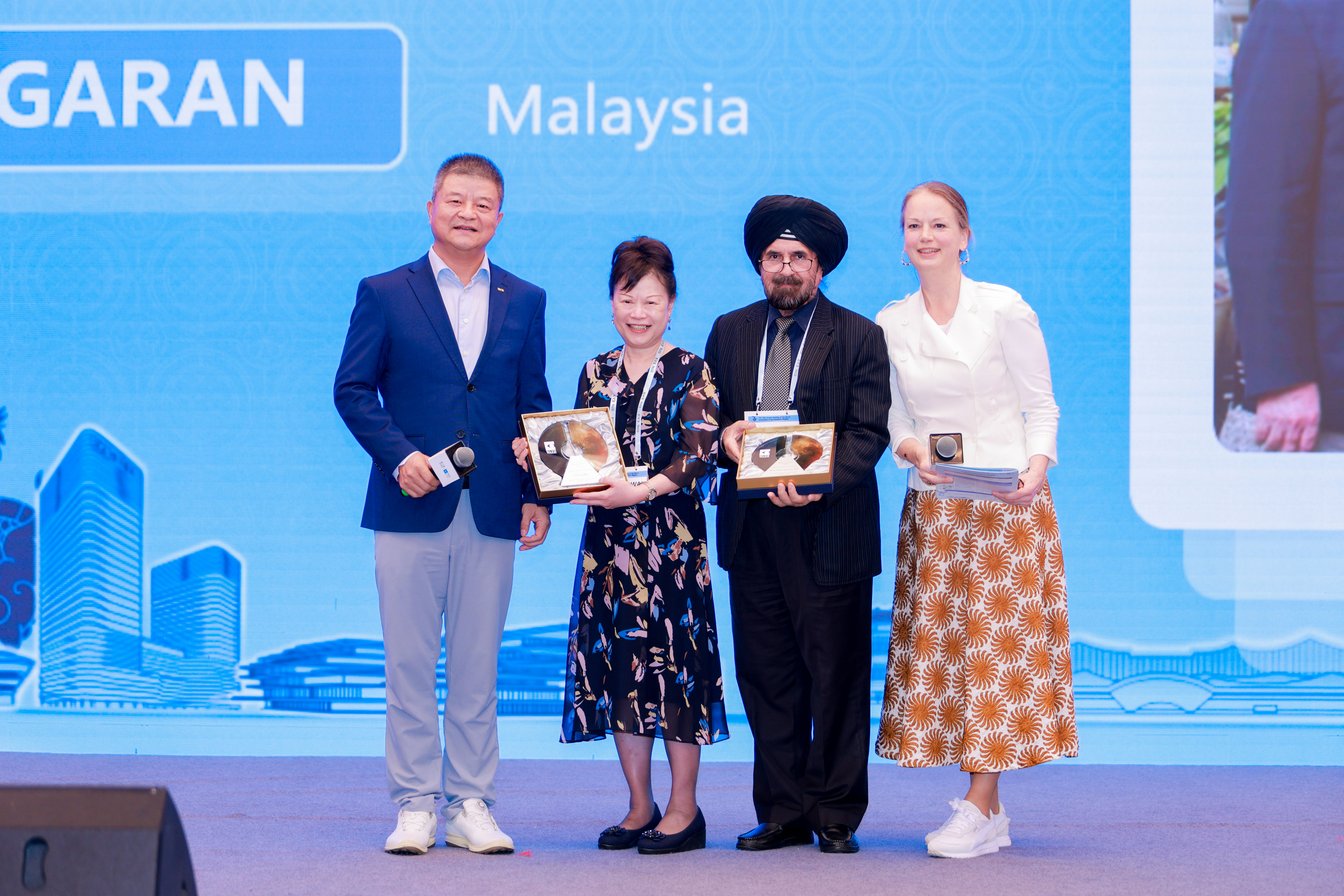
Charity Wai (second from the left) and Dato Kulasegaran (third from the left) were awarded the WAEH Lifetime Achievement Award.
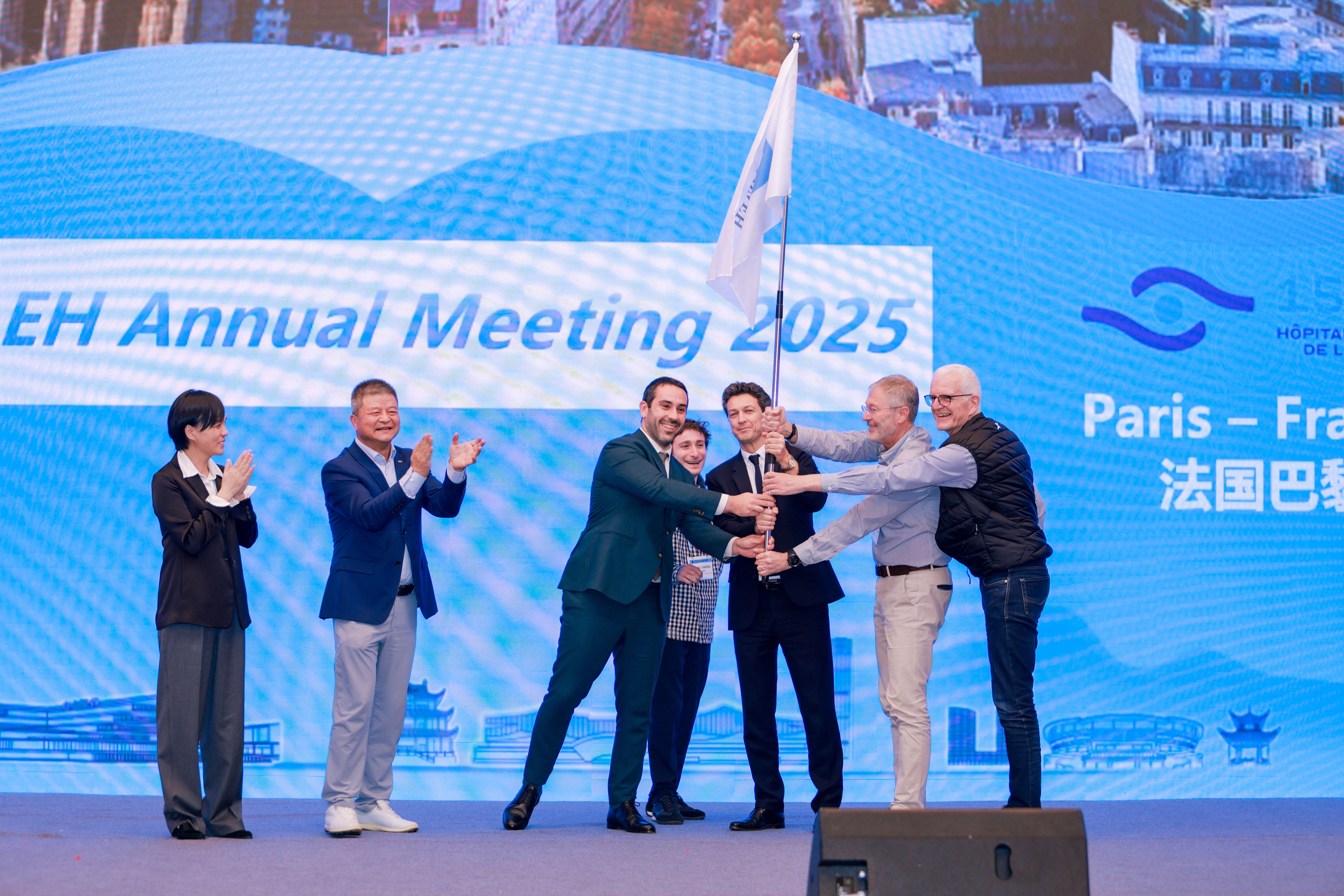
Li Li, Global President of Aier Eye Hospital Group, and Zhang Yongmei, Vice President of Aier Eye Hospital Group and Co-chair of the 18th WAEH Annual Conference, handed over the WAEH flag to representatives from Switzerland and France, the hosts of the next WAEH Annual Conference.
It is reported that the WAEH Lifetime Achievement Award was also presented to Charity Wai, Honorary Board Member of the World Association of Eye Hospitals, and Dato Kulasegaran from the National Eye Hospital of Malaysia. The next WAEH Annual Conference will be jointly hosted by the Asile des Aveugles Foundation in Lausanne, Switzerland, and the National 15-20 Hospital in Paris, France.

Representatives from various member institutions visited the Aier Eye Research Institute.
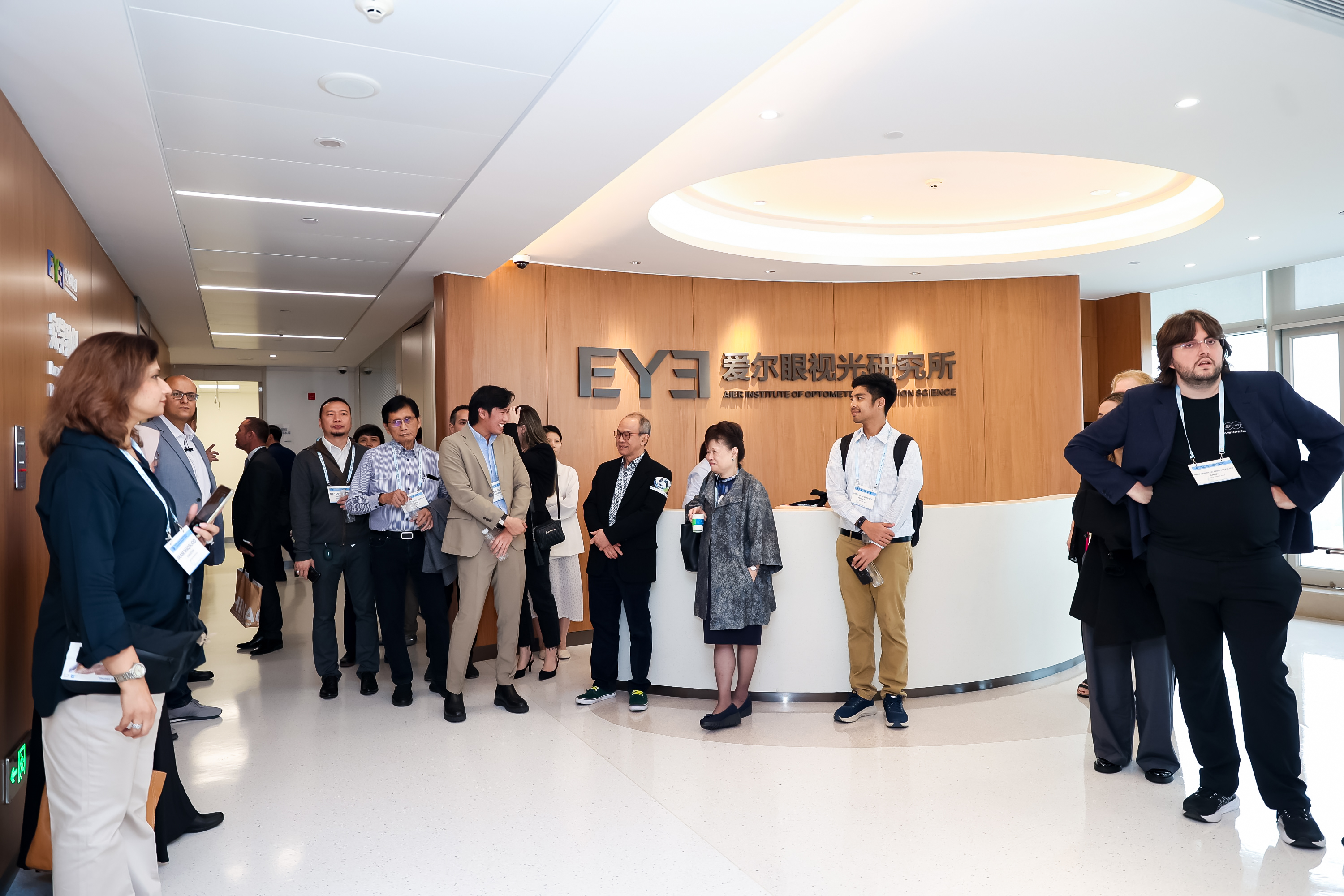
Representatives from various member institutions visited the Aier Optometry Institute.

Representatives from various member institutions visited the Aier International Clinical Training Center.
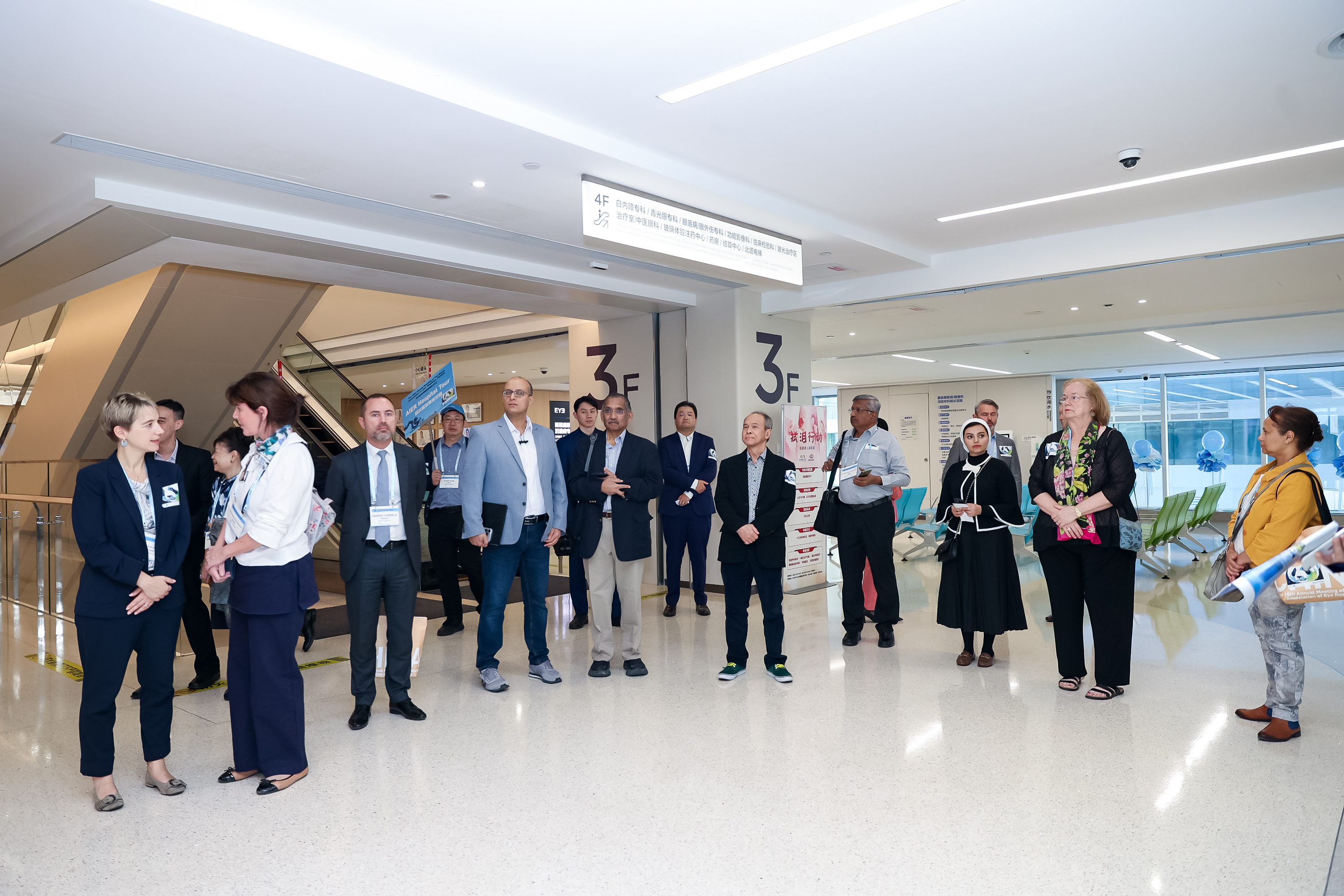
Representatives from various member institutions visited the Changsha Aier Eye Hospital.

Representatives from various member institutions visited the Changsha Aier Children's Ophthalmology Center.

Representatives from various member institutions visited the Changsha Aier Eye Health Science Museum.
In addition, the conference also hosted the "Seeing is Believing" charity run. Representatives from each member institution visited and exchanged experiences at various ophthalmic medical institutions, including the Aier Eye Research Institute, Aier Optometry Institute, Aier International Clinical Training Center, Changsha Aier Eye Hospital, Changsha Aier Children's Eye Hospital, Changsha Aier Eye Health Science Museum, Shanghai Fudan University Eye and ENT Hospital, and Shanghai Aier Eye Hospital.
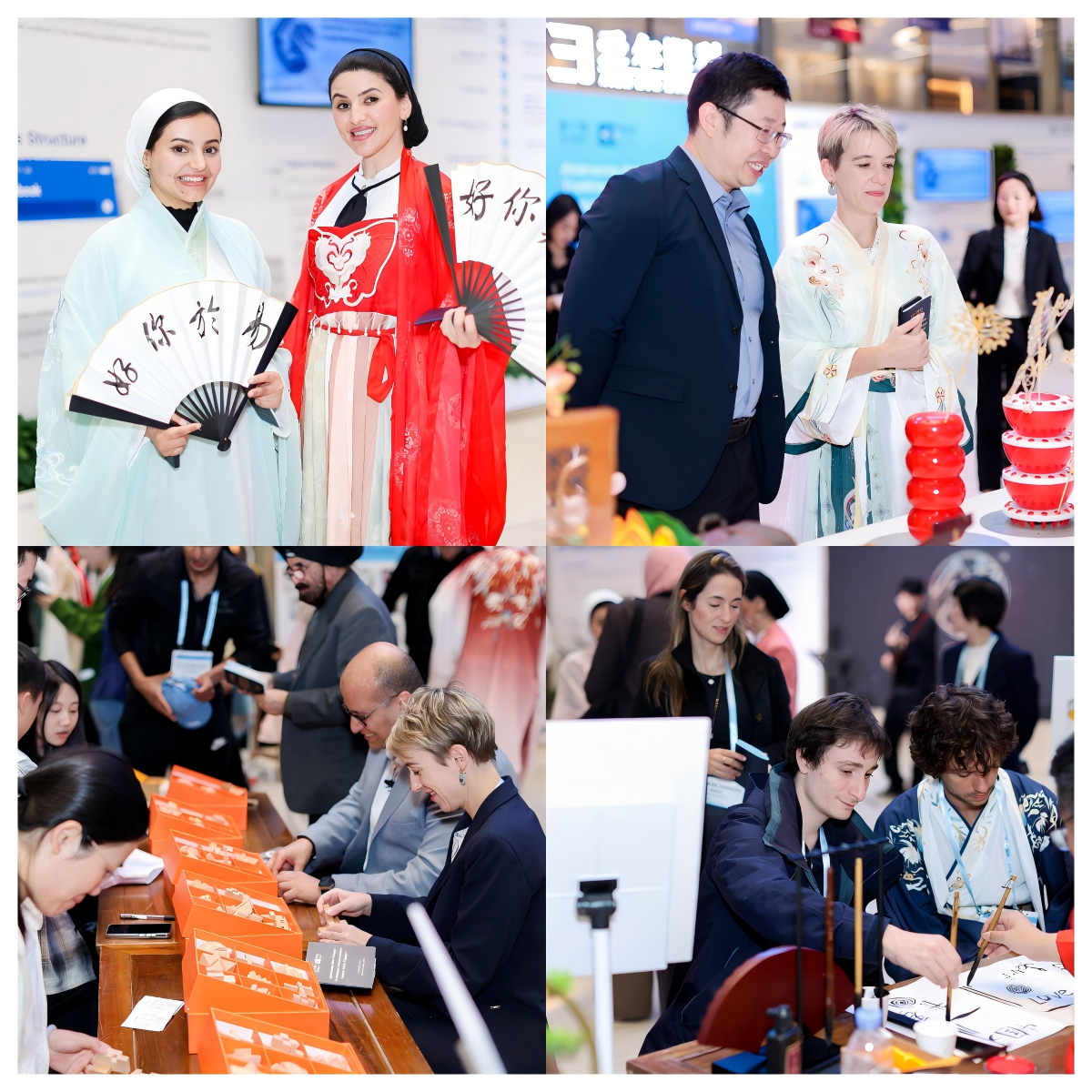
The conference delegates also had an immersive experience in Chinese traditional culture.
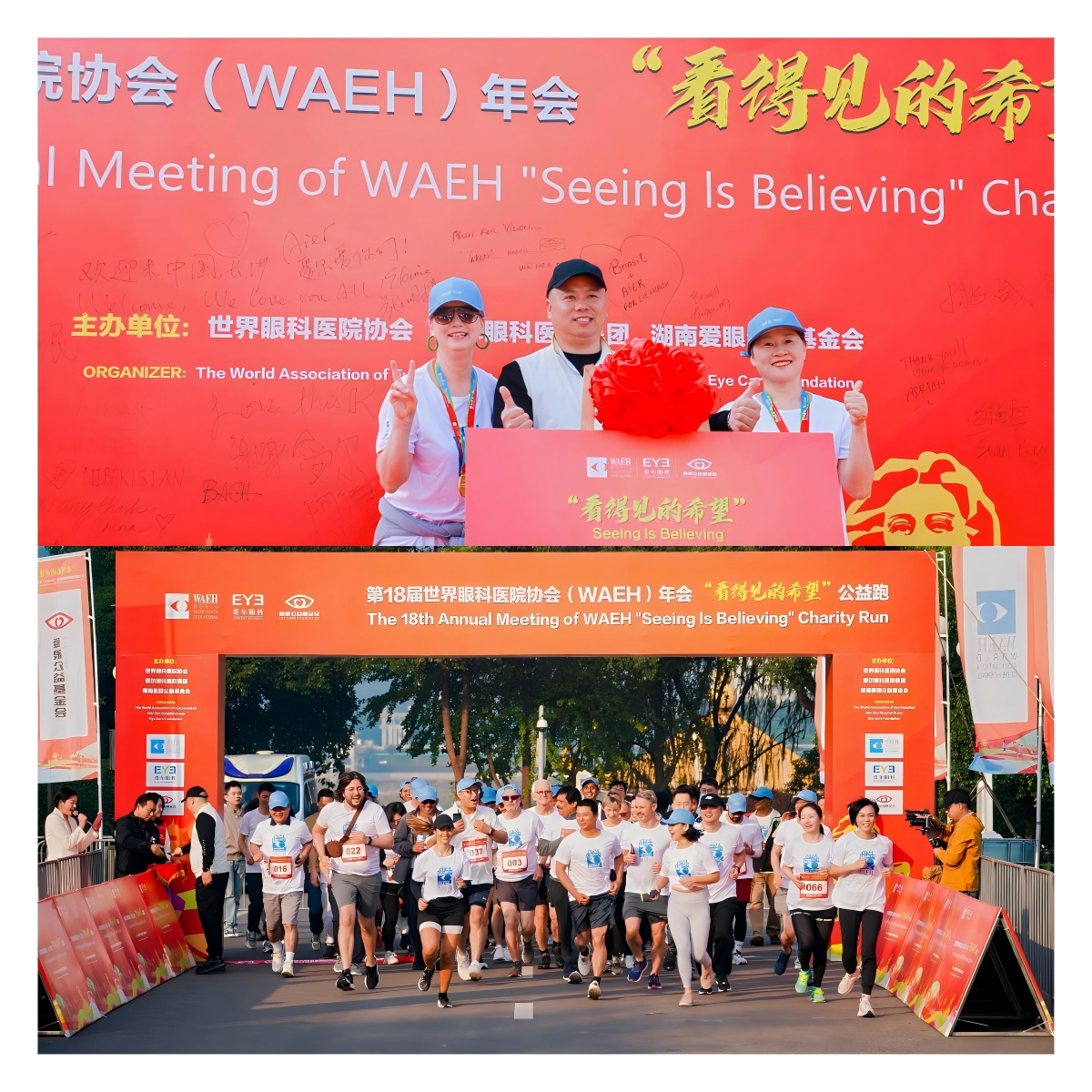
The event also hosted a "Seeing is Believing" charity run.
